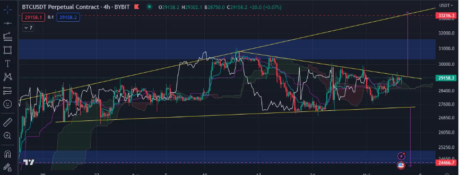The cryptocurrency market has been trading sideways for the past few weeks, with the leading token, Bitcoin, following a similar pattern. Despite numerous attempts in April, Bitcoin has struggled to break the $31,000 mark. The price is blocked by its daily Kijun around $29,100 and by its psychological resistance around $30,000.
A correction to around $25,000 may be preferable to prepare for an extended bull run as long as this zone blocks prices. This would correspond to a retest of the same resistance level at the beginning of the year and can be confirmed as the support level.

In the event of a breach through the $31,000 mark, Bitcoin could continue to climb towards $33,500. This would provide the next level of resistance ahead of a possible rise to $40,000. However, if the bears stay below $25,000, Bitcoin risks breaking the price spread, which could push the price below $18,000.
Related Reading: Polygon bears gain ground as MATIC continues to retreat
Bullish sentiment based on external factors
Bitcoin is in good stead and could make a major bull run due to the following factors. First, the United States and other parts of the world are being ravaged by the banking crisis. Second, there is the decoupling between BTC and traditional markets. Finally, we can mention the brake on interest rates that the US Federal Reserve promised.
The bankruptcy of Silicon Valley Bank in early March continues to wreak havoc on the industry, with many Americans fearing to put their money in the bank. Bitcoin’s recent price surge coincided with this, demonstrating its flexibility as a digital gold.
Read related: UMA Token Up 28% Despite Overall Bearish Trend
There has been a wave of investors to diversify their assets into Bitcoin for good reasons. Bitcoin does not need middlemen; anyone can store BTC in their wallet without trusting a centralized institution. Bitcoin is a unique asset because of its volatility. Sometimes it shows a high correlation with stock indices. Sometimes it deviates and forms its own course. The following chart shows the comparison to gold, the S&P500 and the NASDAQ.
Pearson’s correlation shows how close BTC’s behavior is to that of certain traditional assets. If the shares of banking and fintech companies continue to fall, there will likely be a massive influx of volume into the Bitcoin network, leading to a price increase.
Finally, the Fed raised interest rates to 5.25% per annum. This is the maximum level since 1997. But the increase came with an additional announcement: no further increases (or cuts) are foreseen for the rest of 2023. In general, a deadlock or cut in interest rates is a catalyst for the rise in interest rates. the price of risky assets, such as Bitcoin.
Bitcoin price
At the time of writing, Bitcoin is down 2% in the past 24 hours and is trading at $28,826.

-Featured image iStock, charts from Tradingview













